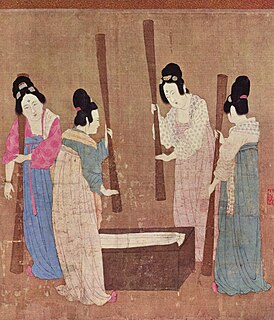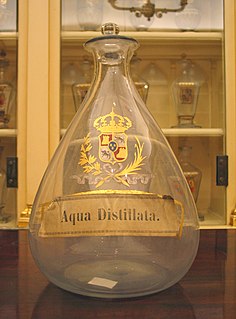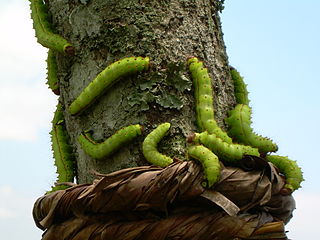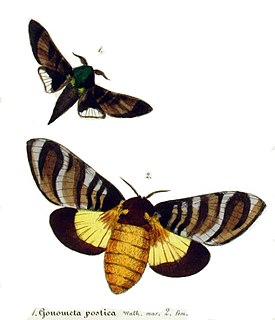Related Research Articles

Silk is a natural protein fiber, some forms of which can be woven into textiles. The protein fiber of silk is composed mainly of fibroin and is produced by certain insect larvae to form cocoons. The best-known silk is obtained from the cocoons of the larvae of the mulberry silkworm Bombyx mori reared in captivity (sericulture). The shimmering appearance of silk is due to the triangular prism-like structure of the silk fibre, which allows silk cloth to refract incoming light at different angles, thus producing different colors.

Citric acid is a weak organic acid that has the chemical formula C
6H
8O
7. It occurs naturally in citrus fruits. In biochemistry, it is an intermediate in the citric acid cycle, which occurs in the metabolism of all aerobic organisms.

Bombyx mori, the domestic silkmoth, is an insect from the moth family Bombycidae. It is the closest relative of Bombyx mandarina, the wild silkmoth. The silkworm is the larva or caterpillar of a silkmoth. It is an economically important insect, being a primary producer of silk. A silkworm's preferred food is white mulberry leaves, though they may eat other mulberry species and even Osage orange. Domestic silkmoths are closely dependent on humans for reproduction, as a result of millennia of selective breeding. Wild silkmoths are different from their domestic cousins as they have not been selectively bred; they are thus not as commercially viable in the production of silk.

Water purification is the process of removing undesirable chemicals, biological contaminants, suspended solids, and gases from water. The goal is to produce water fit for specific purposes. Most water is purified and disinfected for human consumption, but water purification may also be carried out for a variety of other purposes, including medical, pharmacological, chemical, and industrial applications. The methods used include physical processes such as filtration, sedimentation, and distillation; biological processes such as slow sand filters or biologically active carbon; chemical processes such as flocculation and chlorination; and the use of electromagnetic radiation such as ultraviolet light.

Sericulture, or silk farming, is the cultivation of silkworms to produce silk. Although there are several commercial species of silkworms, Bombyx mori is the most widely used and intensively studied silkworm. Silk was believed to have first been produced in China as early as the Neolithic Period. Sericulture has become an important cottage industry in countries such as Brazil, China, France, India, Italy, Japan, Korea, and Russia. Today, China and India are the two main producers, with more than 60% of the world's annual production.

An ion-exchange resin or ion-exchange polymer is a resin or polymer that acts as a medium for ion exchange. It is an insoluble matrix normally in the form of small microbeads, usually white or yellowish, fabricated from an organic polymer substrate. The beads are typically porous, providing a large surface area on and inside them. The trapping of ions occurs along with the accompanying release of other ions, and thus the process is called ion exchange. There are multiple types of ion-exchange resin. Most commercial resins are made of polystyrene sulfonate.

Purified water is water that has been mechanically filtered or processed to remove impurities and make it suitable for use. Distilled water has been the most common form of purified water, but, in recent years, water is more frequently purified by other processes including capacitive deionization, reverse osmosis, carbon filtering, microfiltration, ultrafiltration, ultraviolet oxidation, or electrodeionization. Combinations of a number of these processes have come into use to produce ultrapure water of such high purity that its trace contaminants are measured in parts per billion (ppb) or parts per trillion (ppt).

Ion exchange is an exchange of ions between two electrolytes or between an electrolyte solution and a complex. In most cases the term is used to denote the processes of purification, separation, and decontamination of aqueous and other ion-containing solutions with solid polymeric or mineralic "ion exchangers".
Bombykol is a pheromone released by the female silkworm moth to attract mates. It is also the sex pheromone in the wild silk moth. Discovered by Adolf Butenandt in 1959, it was the first pheromone to be characterized chemically. Minute quantities of this pheromone can be used per acre of land to confuse male insects about the location of their female partners. It can thus serve as a lure in traps to remove insects effectively without spraying crops with large amounts of pesticides. Butenandt named the substance after the moth's Latin name Bombyx mori.

Samia cynthia, the ailanthus silkmoth, is a saturniid moth, used to produce silk fabric but not as domesticated as the silkworm, Bombyx mori. The moth has very large wings of 113–125 mm, with a quarter-moon shaped spot on both the upper and lower wings, whitish and yellow stripes and brown background. There are eyespots on the outer forewings. The species was first described by Dru Drury in 1773.

Bombyx mandarina, the wild silkmoth, is an insect from the moth family Bombycidae. It is the closest relative of Bombyx mori, the domesticated silkmoth. The silkworm is the larva or caterpillar of a silkmoth. Unlike the domesticated relative which is unable to fly or indeed persist outside human care, the wild silkmoth is a fairly ordinary lepidopteran. Its main difference from the domesticated taxon is the more slender body with well-developed wings in males, and the dull greyish-brown colour.

Thai silk is produced from the cocoons of Thai silkworms. Thailand's silkworm farmers cultivate both types of the domesticated silkworms that produce commercial silk: Samia ricini, commonly known as the eri silkworm, which produces matte eri silk, and the Bombyx mori, producer of the better known, glossy mulberry silk. The latter is by far the larger silk producer of the two.
Silk waste includes all kinds of raw silk which may be unwindable, and therefore unsuited to the throwing process. Before the introduction of machinery applicable to the spinning of silk waste, the refuse from cocoon reeling, and also from silk winding, which is now used in producing spun silk fabrics, was nearly all destroyed as being useless, with the exception of that which could be hand-combed and spun by means of the distaff and spinning wheel, a method which is still practised by some of the peasantry in India and other countries in Asia.

Wild silks have been known and used in many countries from early times, although the scale of production is far smaller than that from cultivated silkworms.
Eri silk comes from the caterpillar of Samia ricini, found in northeast India and some parts of China, Japan. It was imported to Thailand in 1974. The name "eri" is derived from the Assamese word "era", which means "castor", as the silkworm feeds on castor plants. Another type of eri silk is "Ailanthus silk moth", refers to the host plant, Borkesseu, Ailanthus excelsa, practiced in China. Eri silk is also known as endi or errandi in India. The woolly white silk is often referred to as the fabric of peace when it is processed without killing the silkworm. This process results in a silk called Ahimsa silk. Moths leave the cocoon and then the cocoons are harvested to be spun. The eri silkworm is the only completely domesticated silkworm other than Bombyx mori.
Sericin is a protein created by Bombyx mori (silkworms) in the production of silk. Silk is a fibre produced by the silkworm in production of its cocoon. It consists mainly of two proteins, fibroin and sericin. Silk consists of 70–80% fibroin and 20–30% sericin; fibroin being the structural center of the silk, and sericin being the gum coating the fibres and allowing them to stick to each other.

Antheraea pernyi, the Chinese (oak) tussar moth, Chinese tasar moth or temperate tussar moth, is a large moth in the family Saturniidae. The species was first described by Félix Édouard Guérin-Méneville in 1855. Antheraea roylei is an extremely close relative, and the present species might actually have evolved from ancestral A. roylei by chromosome rearrangement.
The Bombyx hybrid is a hybrid between a male Bombyx mandarina moth and a female Bombyx mori moth. They produce larvae called silkworms, like all species of Bombyx. The larvae look a lot like the other variations. They are brown in the first half and gray at the bottom half, but they get larger black spots than other variations. Generally, they look like a normal Bombyx moth, but a bit darker. Hybrids are not used for silk, but for research. Because Bombyx mori males lost their ability to fly, their females are much more likely to mate with a male Bombyx mandarina. The reverse is possible, but both species have to be kept in the same container. Since Bombyx hybrids are much more common than the other variation, more is known about them.

Gonometa postica, known commonly as the African wild silk moth, burn worm, and brandwurm, is a large species of African moth belonging to the family Lasiocampidae. The genus Gonometa boasts some very large moths and larvae; Gonometa sjostedti from Africa has a larva 16 centimeters long, for example. Most of the Lasiocampidae are highly sexually dimorphic. In G. postica the forewing of the male measures 21–25 mm and of the female 35–42 mm.
Ahimsa Silk is a method of non-violent silk breeding and harvesting. Wild silk moths are bred, rather than the domestic variety. It allows the completion of the metamorphosis of the silkworm to its moth stage, whereas most silk harvesting requires the silkworms to be killed in their cocoon stage. No animals suffer or die for the silk to be produced, making it a favorable alternative to normal silk for those who do not believe in harming animals.
References
- ↑ PhysOrg (17 May 2011). "Reeling in a wild silk harvest". PhysOrg. Retrieved 26 May 2011.
- ↑ Science Daily (22 May 2011). "New Method of Unreeling Cocoons Could Extend Silk Industry Beyond Asia". ScienceDaily. Retrieved 26 May 2011.
- ↑ Sindya N. Bhanoo (20 May 2011). "Silk Production Takes a Walk on the Wild Side". New York Times. Retrieved 26 May 2011.
- ↑ Gheysens, T; Collins, A; Raina, S; Vollrath, F; Knight, D (2011). "Demineralization enables reeling of Wild Silkmoth cocoons". Biomacromolecules. 12 (6): 2257–66. doi:10.1021/bm2003362. PMID 21491856.
- ↑ GB 1018269.9,Gheysens, T,"Demineralization Enables Reeling of Wild Silkmoth Cocoons" (patent pending)